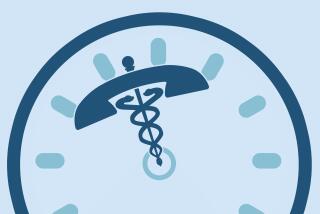Report Highlights Inequities in Access to Medical Care
- Share via
More than a quarter of the people in the Southland lack health insurance, poor people and ethnic minorities often face more severe health problems than wealthier whites, and emergency and reproductive health services are spread increasingly thin.
Such is the mixed diagnosis offered in a comprehensive report on health care in eight counties, including Los Angeles, released by the Southern California Study Center at USC.
However “well endowed” the region’s overall system, the Health Atlas of Southern California says its resources are “unevenly distributed across the region and its populations.” Access to care remains elusive for many people.
“If I had to pick one [problem], it’s access in its many dimensions--physical access, access to the emergency medical system, financial access, and cultural access for all the different ethnic groups,” said Michael Dear, the study center’s director and atlas co-editor.
One of the biggest hurdles is a lack of insurance coverage. According to the research, Los Angeles County alone has 2.7 million uninsured people, including nearly 700,000 children. Half of the uninsured are foreign born, many of them Latino and from working families.
The result is that many people delay seeking health care and preventive screenings or do not obtain them at all. In Los Angeles County, uninsured people with diabetes or hypertension are three times more likely to be without a doctor’s care than are those who have insurance or Medi-Cal.
“Until we make significant moves to reduce the number of uninsured . . . the ‘good part’ of the [health care] system will remain very limited,” said Michael Cousineau, the USC researcher who wrote the atlas chapter on insurance coverage. “This is a serious problem we haven’t dealt with. Government has yet to adequately address it.”
Even people who have insurance often face choices limited by managed care. The atlas notes that here, in this “bellwether region for managed care,” many people have become disenchanted with restrictions in choice of providers and access to services. At the same time, managed care entities are seeing a drop in earnings.
Obtaining reproductive care represents an access problem of a different kind. The atlas notes that mergers and acquisitions have led to a substantial increase in the percentage of hospitals affiliated with religious groups. Twenty-two of Los Angeles County’s 113 general acute care hospitals are religiously affiliated, mostly with the Roman Catholic Church.
Religious affiliation is a good thing in one sense because faith-based institutions tend to be committed to the poor and uninsured and continue to serve communities even when profits dip, the researchers noted. However, religious affiliations have slowly chipped away women’s access to abortions, contraception and fertility treatments, the atlas notes.
“That in some ways is like a small time bomb hidden away in this report . . . a time bomb ticking away at the heart of the system,” Dear says.
Emergency services are slowly eroding as well. According to the report, as of December 1997 there were 95 hospitals in Los Angeles County capable of tending to emergency illnesses and injuries, 15% fewer than seven years earlier. The most obviously underserved areas, researchers said, are the Antelope Valley and South Los Angeles.
Moreover, the county has only 13 trauma centers; 15 years ago, there were 23. Many centers are treating people outside their immediate area, and some, like Martin Luther King Jr./Drew Medical Center, are seeing greater severity in emergency cases.
The report raises a controversial issue in emergency medicine: whether time spent stabilizing critically injured patients in the field might be better spent transporting them to the nearest trauma center as soon as possible--the so-called scoop and run approach.
USC researchers have found that patients ferried by private transportation--fewer than 15% of trauma patients--are more likely to survive than those transported by the county’s Emergency Medical Transport paramedics. Private patients also tend to arrive at the hospital much faster, possibly because they are not subject to the same stabilization procedures the paramedics use. The atlas recommends looking at whether scoop and run might save more lives.
The atlas highlights many of the region’s gains as well. The area ranks better than the national average on many health indicators, with lower mortality rates from coronary artery disease and cancer in every county. Most counties also have achieved federal objectives for 2000 in reducing adolescent pregnancy, gonorrhea and AIDS. The region also has made progress reducing air pollution from particulates and ozone.
With regard to AIDS, however, the researchers added a big caveat. The AIDS death rate is declining because of new drug treatments, the atlas notes. But that doesn’t mean the human immunodeficiency virus is on the wane. In fact, infection rates are going up significantly in some populations, most notably African American women.
(BEGIN TEXT OF INFOBOX / INFOGRAPHIC)
No Health Insurance
More than a quarter of the people in Southern California, and 2 .7 million in Los Angeles County, lack health insurance. Nearly 700,000 children countywide are uninsured.
*
Notes: Figures may not total 100 because of rounding. $33,400 represents 200% of U.S. poverty level.
Source: Health Atlas of Southern California, University of Southern California
More to Read
Sign up for Essential California
The most important California stories and recommendations in your inbox every morning.
You may occasionally receive promotional content from the Los Angeles Times.













